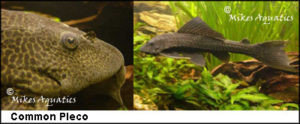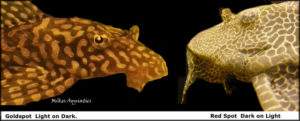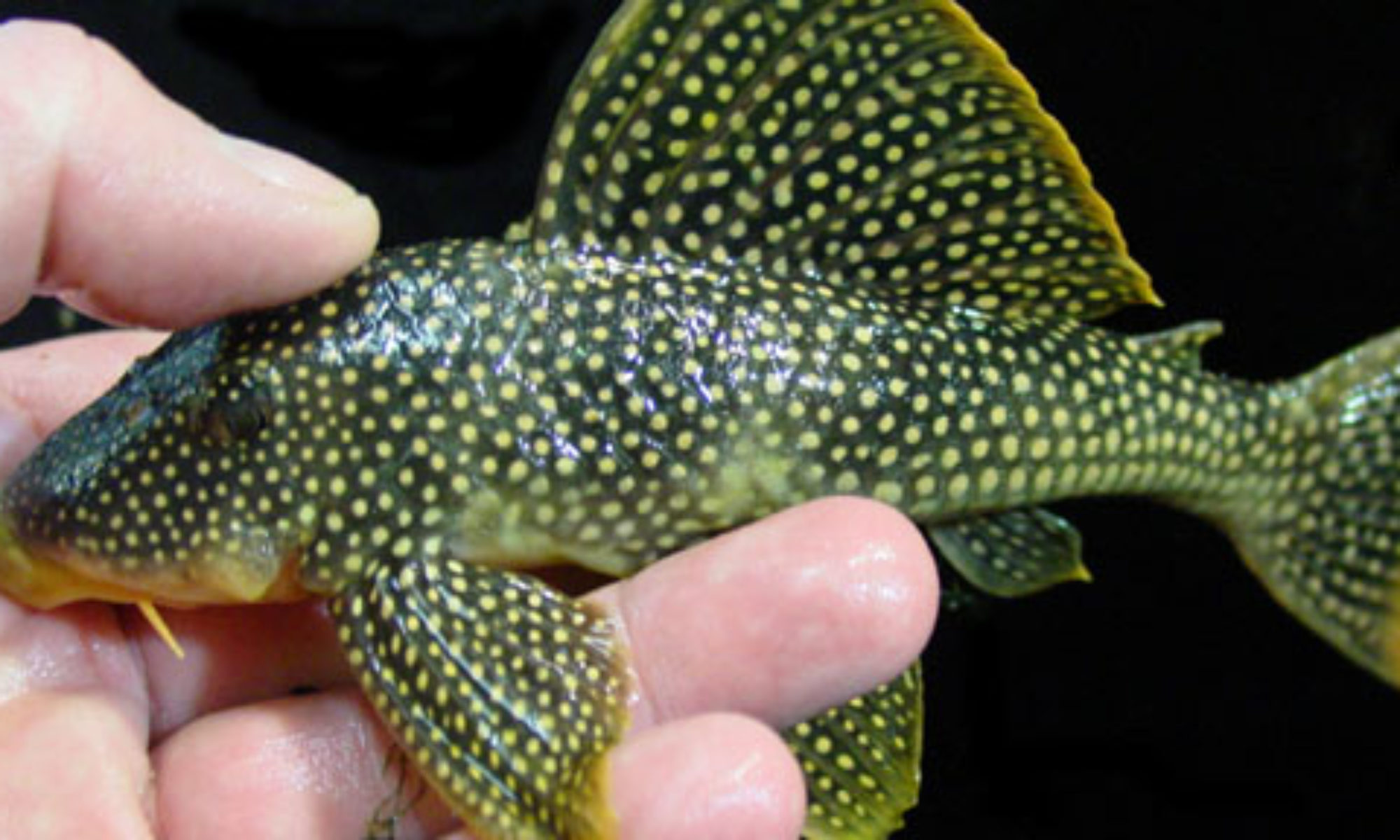Common Plec’s in NZ
Looking for a ‘Pleco’ clean up crew to clean the algae from the glass and plants in your tanks ? These are the plec’s that you are most likely to come across in your LFS.
COMMON PLECOSTOMUS.

Usually this is actually Pterygoplichthys pardalis (L021 L023) and is usually sold as a cheap catfish to clean algae from a community tank. They are long lived, peaceful and armour plated so safe with most other tank inhabitants; they don’t eat plants although they may uproot them occasionally while moving about. Unfortunately given their large eventual size and generally poor performance at cleaning algae as they get larger they are a poor choice for the average aquarist. The cute little pleco quickly outgrows most tanks and produces a lot of waste thus clogging up the filtration system. Given their eventually size of 35-40 cms I would consider a 250 Litre tank as the minimum size for a common plec.
RED SPOT & GOLD SPOT PLECOSTOMUS

While actually two different species the Red Spot Pterygoplichthys gibbiceps L083, L164, L196 and the Gold Spot Pterygoplichthys joselimaianus L01 are practically identical in all but color. The Red Spot has dark colored splotches and squiggles on a Light Tan Background, the Gold Spot has Tan Splotches and Squiggles on a dark colored background, the Red Spot also has a slightly larger Dorsal Fin, and is sometimes sold as a Sail Fin pleco.

Usually sold as a small somewhat cute fish around 1 to 2 inches long. These are a fast growing eating machine. The specimen in the photo above is around 40cm long and 24 years old as of 2017. They are slightly more aggressive than common plecs but still peaceful although they can cause problems for more timid tank mates by out competing them for food. Recommended only for a larger tank (minimum 250 litres) as they quickly outgrow most small tanks and produce huge amounts of waste overloading the filtration system. Ideal as a ‘clean up crew’ for a tank with larger cichlids or boisterous fish but not really suited to the average ‘community’ tank. Will not eat plants but may uproot them while moving about, good at keeping green algae’s in check but they get lazy if overfed on fish food and start ignoring the algae.
BRISTLE NOSE CATFISH
 Ancistrus sp (3) The common Bristle Nose Catfish or Bushy Nose Catfish is the ideal sucker mouth catfish for any tank, in fact I recommend every tank have at least one of these guys (every tank I have has a BN clean up crew). They are hardy, long lived, armor plated, excellent algae eaters, peaceful and relatively easy to spawn. They tolerate a wide range of water conditions and max out at around 15 cms in size. The males have the extensive bushy whiskers, the females also have them much they are much smaller. There are a few variants including The Golden Bristle Nose (an albino form of sp3) the Black Eyed Golden (L144) and hybrid mixes of all three. Other than every scrap of algae they can find they eat any sinking food pellets (although vegetable based ones are preferred) they also love courgette. All in all the perfect pleco for most community tanks.
Ancistrus sp (3) The common Bristle Nose Catfish or Bushy Nose Catfish is the ideal sucker mouth catfish for any tank, in fact I recommend every tank have at least one of these guys (every tank I have has a BN clean up crew). They are hardy, long lived, armor plated, excellent algae eaters, peaceful and relatively easy to spawn. They tolerate a wide range of water conditions and max out at around 15 cms in size. The males have the extensive bushy whiskers, the females also have them much they are much smaller. There are a few variants including The Golden Bristle Nose (an albino form of sp3) the Black Eyed Golden (L144) and hybrid mixes of all three. Other than every scrap of algae they can find they eat any sinking food pellets (although vegetable based ones are preferred) they also love courgette. All in all the perfect pleco for most community tanks.
OTOCINCLOS CATFISH
 If you are looking for a smaller algae eater then Otto cats are the ones for you. In NZ they are usually Otocinclos vittatus but other varieties are available from time to time. Ottos are vegetarians so need a diet of greens, tank algae, courgette, blanched lettuce etc. They are also a shoaling fish and should be kept in groups of at least 5 or 6. Maxing out at around 1.5 inches they are an ideal ‘clean up crew’ for smaller tanks as long as you are prepared to supplement the usual community flakes diet with some extra greens.
If you are looking for a smaller algae eater then Otto cats are the ones for you. In NZ they are usually Otocinclos vittatus but other varieties are available from time to time. Ottos are vegetarians so need a diet of greens, tank algae, courgette, blanched lettuce etc. They are also a shoaling fish and should be kept in groups of at least 5 or 6. Maxing out at around 1.5 inches they are an ideal ‘clean up crew’ for smaller tanks as long as you are prepared to supplement the usual community flakes diet with some extra greens.
